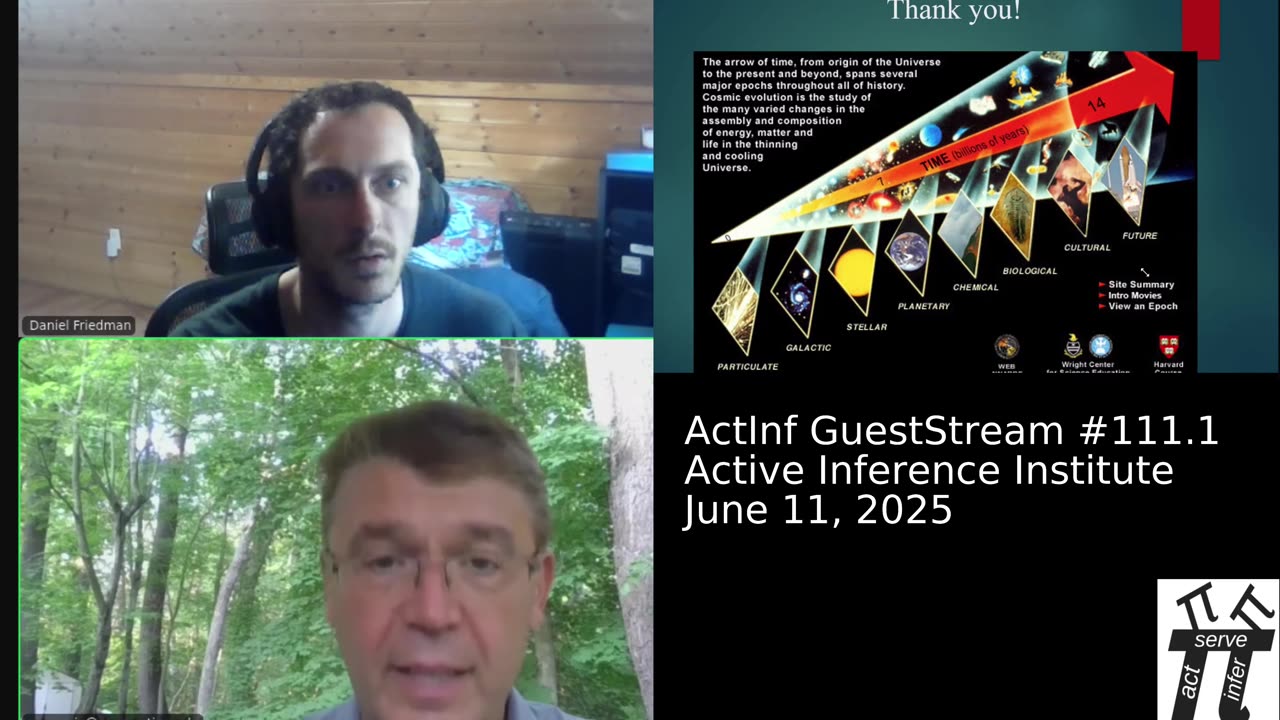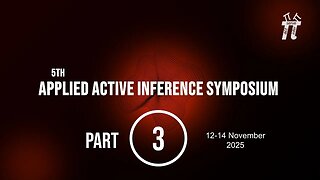Premium Only Content

ActInf GuestStream 111.1 ~ Modeling and Predicting Self-Organization in Dynamic Systems (G Georgiev)
Modeling and Predicting Self-Organization in Dynamic Systems out of Thermodynamic Equilibrium: Part 1: Attractor, Mechanism and Power Law Scaling
https://www.mdpi.com/2227-9717/12/12/2937
by Matthew Brouillet, and Georgi Yordanov Georgiev
Abstract:
Self-organization in complex systems is a process associated with reduced internal entropy and the emergence of structures that may enable the system to function more effectively and robustly in its environment and in a more competitive way with other states of the system or with other systems. This phenomenon typically occurs in the presence of energy gradients, facilitating energy transfer and entropy production. As a dynamic process, self-organization is best studied using dynamic measures and principles. The principles of minimizing unit action, entropy, and information while maximizing their total values are proposed as some of the dynamic variational principles guiding self-organization. The least action principle (LAP) is the proposed driver for self-organization; however, it cannot operate in isolation; it requires the mechanism of feedback loops with the rest of the system’s characteristics to drive the process. Average action efficiency (AAE) is introduced as a potential quantitative measure of self-organization, reflecting the system’s efficiency as the ratio of events to total action per unit of time. Positive feedback loops link AAE to other system characteristics, potentially explaining power–law relationships, quantity–AAE transitions, and exponential growth patterns observed in complex systems. To explore this framework, we apply it to agent-based simulations of ants navigating between two locations on a 2D grid. The principles align with observed self-organization dynamics, and the results and comparisons with real-world data appear to support the model. By analyzing AAE, this study seeks to address fundamental questions about the nature of self-organization and system organization, such as “Why and how do complex systems self-organize? What is organization and how organized is a system?”. We present AAE for the discussed simulation and whenever no external forces act on the system. Given so many specific cases in nature, the method will need to be adapted to reflect their specific interactions. These findings suggest that the proposed models offer a useful perspective for understanding and potentially improving the design of complex systems.
Active Inference Institute information:
Website: https://www.activeinference.institute/
Activities: https://activities.activeinference.institute/
Discord: https://discord.activeinference.institute/
Donate: http://donate.activeinference.institute/
YouTube: https://www.youtube.com/c/ActiveInference/
X: https://x.com/InferenceActive
Active Inference Livestreams: https://video.activeinference.institute/
-
 10:26:08
10:26:08
Active Inference Institute
1 month ago5th Applied Active Inference Symposium (Part 3, Nov 14, 2025) ~ LIVE
9 -
 UPCOMING
UPCOMING
The Amber May Show
3 hours agoLaw & Disorder: FBI Shakeups, Arrest Waves, and a Culture That’s Gone Off the Rails
52 -
 1:01:16
1:01:16
Timcast
1 hour agoTrump TROLLS Legacy Media, Announces WARRIOR DIVIDEND, Venezuela Fake Out
43.5K8 -
 1:25:01
1:25:01
Misfits Mania
1 day ago $5.52 earnedMISFITS MANIA: Press Conference
12K5 -
 DVR
DVR
Graham Allen
1 hour agoLive From AMFEST 2025: Day 1
12.5K2 -
 1:56:43
1:56:43
Steven Crowder
4 hours agoLWC Christmas Special 2025 | Giving Back with Santa Crowder
200K67 -
 14:33
14:33
Robbi On The Record
3 hours ago $1.97 earnedNPC Girls & The Digital Dehumanization of Women
12.6K7 -
 53:25
53:25
Simply Bitcoin
1 day ago $0.64 earnedThe Bitcoin Crucible w/ Alex Stanczyk & Tomer Strolight - Episode 13
15K1 -
 59:21
59:21
The Rubin Report
2 hours agoIs This the Real Reason Bongino Is Leaving the FBI?
28.8K40 -
 LIVE
LIVE
LFA TV
14 hours agoLIVE & BREAKING NEWS! | THURSDAY 12/18/25
3,245 watching